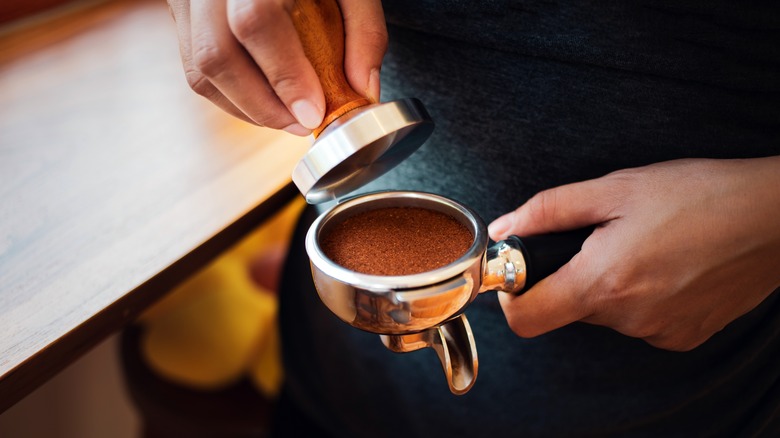Here's What An Espresso Tamper Actually Does For Your Coffee
Coffee may be a simple pleasure, but it's also a necessary one for many of us. Whether we drink it hot in the morning to get the day started or as an icy treat in the afternoon, coffee would be nothing without its jittery child: Espresso. It's the substance that gives you the real kick you need, and a vital ingredient in macchiatos, Americanos, and more. But what exactly is espresso? We know it stems from coffee grounds and water, but espresso requires more than just mixing those two things together.
Like anything worth having in life, espresso comes from pressure — the pressure of water through coffee grounds, to be exact. But you can't just pour water over coffee and expect to get the delicious elixir. The thing most necessary to bring espresso into existence is the tamper. A common tool you may have seen your local barista use, the tamper packs ordinary coffee grounds into a hard puck that water is forced through to create espresso. And when done properly, it gives you unbelievably tasty returns.
Why espresso needs a tamper
Achieving the perfect espresso shot requires specific steps — as well as tools — to work. Even before the tamping can begin, the coffee has to undergo the proper process. The espresso beans must be roasted and ground as finely as possible with a grinder. Once completed, the grounds can be packed together to create an almost solid structure. The preparation process is instrumental because the water needs to filter slowly through the grounds; if the grounds are loose or uneven, the water will flow too easily through and not gather the proper oils. A tamper, however, allows you to tamp the grounds solidly into its portafilter, creating a tightly packed consistency that guarantees a slow — and correct — filtering process.
However, there is an art to using the tamper. You don't want to pack the espresso too tightly, or the water can't flow through the grounds at all. When using a tamper, you may need to practice and experiment a bit to find a happy medium that will result in your preferred espresso shot. Though not the easiest skill to achieve, you will be happy when you do. Whether making espresso at home or for your vocation, learning how to tamp means the difference between a good espresso shot and an unsatisfying drink.
How a tamper affects your espresso
The term espresso applies both to how a coffee is brewed and to the drink itself. A shot of espresso is essentially a shot of strong coffee with a topping of crema — a thick layer that settles on top of the espresso that experts would rather you not drink. This concoction can only come about through the espresso process of pressure, water, and a tamper. When properly brewed with the correct timing and tamping, the benefits of espresso are numerous.
The first is the most obvious — the taste. Espresso taste varies from your run-of-the-mill cup of coffee. Coffee is generally milder, whereas the taste of espresso is stronger and more flavorful. Espresso is also known to have some health benefits. A study published in Nature Neuroscience suggests that espresso can improve brain function, including memory. It can also help with your mood and — unsurprisingly — your energy level. The Harvard School of Health states that consuming espresso may have a positive influence on diabetes, citing a report that claims espresso could decrease the risk of type 2 diabetes. Since properly made espresso boasts both a great taste and a possibility of health benefits, there's all the more reason to ensure you are getting the best-tamped grounds around.


